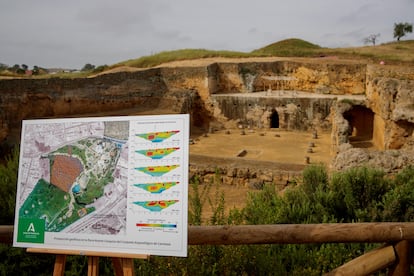A team from the Department of Organic Chemistry of the University of Córdoba, led by Professor José Rafael Ruiz Arrebola, in collaboration with the Carmona City Council, has discovered that in the necropolis of that Sevillian town there is the oldest wine in the world, with more than 2,000 years. This discovery supersedes the Speyer wine bottle, discovered in 1867 and dated to the 4th century AD. C, which is preserved in the Historical Museum of Pfalz (Germany).
In a press release, the Scientific Culture and Innovation Unit, dependent on the Ministry of Science and Innovation, argues that Hispana, Senicio and the other four bodies (two men and two women of unknown names) from a Roman tomb of Carmona, discovered in 2019, “they never imagined that what for them was a funerary ritual would end up being relevant 2,000 years later for another reason.”
The funerary ritual, it has been discovered, immersed the skeletal remains of one of the men in a liquid inside a glass funerary urn. This liquid, which over time has acquired a reddish tone, has been preserved since the 1st century AD “At first we were very surprised that this liquid was preserved in one of the funerary urns,” explained the municipal archaeologist of the Carmona City Council, Juan Manuel Roman. However, the conservation conditions of the tomb, which has been preserved “intact and well sealed” during all that time, “is what has made it possible for the wine to maintain its natural state and to rule out other possible causes for this liquid, such as flooding or leaks inside the chamber or condensation processes.”
The challenge of the study was to verify the suspicions that the research team had, and that is that “that reddish liquid was wine or, rather, that at another time it was wine because it had already lost many of its essential characteristics.” To clarify this, they have resorted to a series of chemical analyzes carried out at the Central Research Support Service (SCAI) of the UCO. Their discovery has been published in the journal Journal of Archaeological Science: Reports.
The team studied the pH, the absence of organic matter, mineral salts, the presence of certain chemical compounds that could be related to the glass of the urn or the bones of the deceased, and compared it with current wines from Montilla-Moriles, Jerez or Sanlúcar. Thanks to this they had the first indications that the liquid was wine. However, the key was polyphenols, biomarkers present in all wines. Thanks to a technique capable of identifying these compounds in very low quantities, the team found seven specific polyphenols that were also present in wines from Montilla-Moriles, Jerez or Sanlúcar.
The absence of a specific polyphenol, syringic acid, has served to identify the wine as white. Despite this, and despite the fact that this typology of wine agrees with bibliographic, archaeological and iconographic sources, the team has clarified that the fact that said acid is not present may be due to degradation due to the passage of time. Likewise, they point out that the “most difficult” thing has been determining the origin of the wine, since there is no sample from the same era to compare. Even so, the mineral salts present in the liquid from the tomb are consistent with the white wines currently produced in the territory of Andalusia, the ancient Baetic province.
The fact that wine covered the skeletal remains of a man is no coincidence. Women in ancient Rome were long prohibited from tasting wine. The two glass urns in Carmona’s tomb are an example of the gender division of Roman society and funerary rituals. Therefore, if the bones of a man were immersed in wine together with a gold ring and other worked bone remains from the funerary bed in which he had been cremated, the urn containing the remains of a woman did not have a single drop of wine, but three amber jewels, a perfume bottle with a patchouli aroma and remains of fabrics whose first analyzes seem to indicate that they were silk, they add.
In short, the wine, as well as the rings, perfume and other elements were part of a funerary trousseau that would accompany the deceased on their journey to the afterlife. In ancient Rome, death had a special meaning and people wanted to be remembered to, in some way, stay alive. This tomb, actually a circular mausoleum that probably housed a family with high purchasing power, was located – next to the important road that connected Carmona with Hispalis (Seville) – and marked with a tower (now missing).
“Two thousand years later, and after a long time in oblivion,” the bodies of Hispana, Senicio and their four companions have not only been remembered again, but have also offered a lot of information about the funerary rituals of ancient Rome, allowing, in addition, , “identify the wine from the glass urn as the oldest liquid wine in the world,” the researchers have stressed.

